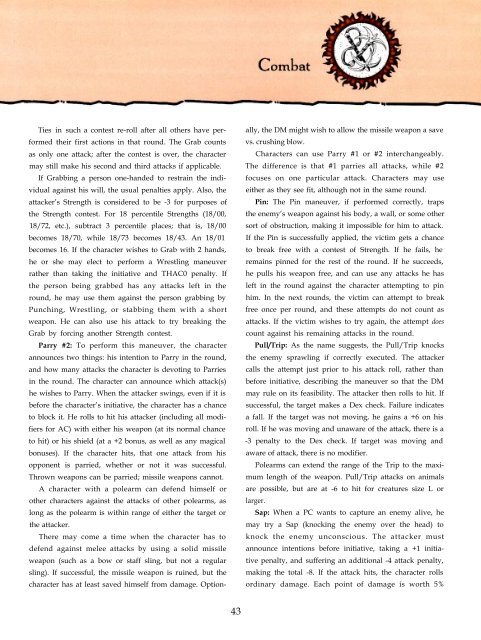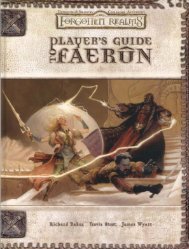CGR2 - The Complete Gladiator's Handbook
CGR2 - The Complete Gladiator's Handbook
CGR2 - The Complete Gladiator's Handbook
You also want an ePaper? Increase the reach of your titles
YUMPU automatically turns print PDFs into web optimized ePapers that Google loves.
Ties in such a contest re-roll after all others have performed<br />
their first actions in that round. <strong>The</strong> Grab counts<br />
as only one attack; after the contest is over, the character<br />
may still make his second and third attacks if applicable.<br />
If Grabbing a person one-handed to restrain the individual<br />
against his will, the usual penalties apply. Also, the<br />
attacker’s Strength is considered to be -3 for purposes of<br />
the Strength contest. For 18 percentile Strengths (18/00,<br />
18/72, etc.), subtract 3 percentile places; that is, 18/00<br />
becomes 18/70, while 18/73 becomes 18/43. An 18/01<br />
becomes 16. If the character wishes to Grab with 2 hands,<br />
he or she may elect to perform a Wrestling maneuver<br />
rather than taking the initiative and THAC0 penalty. If<br />
the person being grabbed has any attacks left in the<br />
round, he may use them against the person grabbing by<br />
Punching, Wrestling, or stabbing them with a short<br />
weapon. He can also use his attack to try breaking the<br />
Grab by forcing another Strength contest.<br />
Parry #2: To perform this maneuver, the character<br />
announces two things: his intention to Parry in the round,<br />
and how many attacks the character is devoting to Parries<br />
in the round. <strong>The</strong> character can announce which attack(s)<br />
he wishes to Parry. When the attacker swings, even if it is<br />
before the character’s initiative, the character has a chance<br />
to block it. He rolls to hit his attacker (including all modifiers<br />
for AC) with either his weapon (at its normal chance<br />
to hit) or his shield (at a +2 bonus, as well as any magical<br />
bonuses). If the character hits, that one attack from his<br />
opponent is parried, whether or not it was successful.<br />
Thrown weapons can be parried; missile weapons cannot.<br />
A character with a polearm can defend himself or<br />
other characters against the attacks of other polearms, as<br />
long as the polearm is within range of either the target or<br />
the attacker.<br />
<strong>The</strong>re may come a time when the character has to<br />
defend against melee attacks by using a solid missile<br />
weapon (such as a bow or staff sling, but not a regular<br />
sling). If successful, the missile weapon is ruined, but the<br />
character has at least saved himself from damage. Option-<br />
43<br />
ally, the DM might wish to allow the missile weapon a save<br />
vs. crushing blow.<br />
Characters can use Parry #1 or #2 interchangeably.<br />
<strong>The</strong> difference is that #1 parries all attacks, while #2<br />
focuses on one particular attack. Characters may use<br />
either as they see fit, although not in the same round.<br />
Pin: <strong>The</strong> Pin maneuver, if performed correctly, traps<br />
the enemy’s weapon against his body, a wall, or some other<br />
sort of obstruction, making it impossible for him to attack.<br />
If the Pin is successfully applied, the victim gets a chance<br />
to break free with a contest of Strength. If he fails, he<br />
remains pinned for the rest of the round. If he succeeds,<br />
he pulls his weapon free, and can use any attacks he has<br />
left in the round against the character attempting to pin<br />
him. In the next rounds, the victim can attempt to break<br />
free once per round, and these attempts do not count as<br />
attacks. If the victim wishes to try again, the attempt does<br />
count against his remaining attacks in the round.<br />
Pull/Trip: As the name suggests, the Pull/Trip knocks<br />
the enemy sprawling if correctly executed. <strong>The</strong> attacker<br />
calls the attempt just prior to his attack roll, rather than<br />
before initiative, describing the maneuver so that the DM<br />
may rule on its feasibility. <strong>The</strong> attacker then rolls to hit. If<br />
successful, the target makes a Dex check. Failure indicates<br />
a fall. If the target was not moving, he gains a +6 on his<br />
roll. If he was moving and unaware of the attack, there is a<br />
-3 penalty to the Dex check. If target was moving and<br />
aware of attack, there is no modifier.<br />
Polearms can extend the range of the Trip to the maximum<br />
length of the weapon. Pull/Trip attacks on animals<br />
are possible, but are at -6 to hit for creatures size L or<br />
larger.<br />
Sap: When a PC wants to capture an enemy alive, he<br />
may try a Sap (knocking the enemy over the head) to<br />
knock the enemy unconscious. <strong>The</strong> attacker must<br />
announce intentions before initiative, taking a +1 initiative<br />
penalty, and suffering an additional -4 attack penalty,<br />
making the total -8. If the attack hits, the character rolls<br />
ordinary damage. Each point of damage is worth 5%





